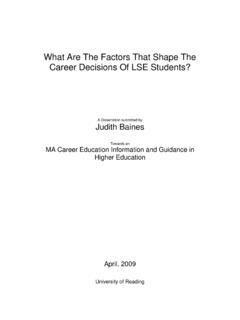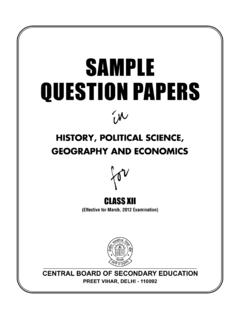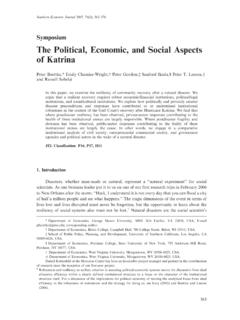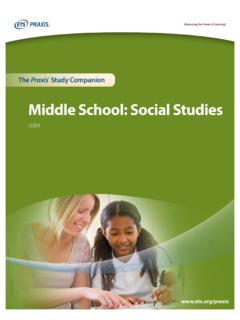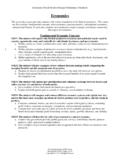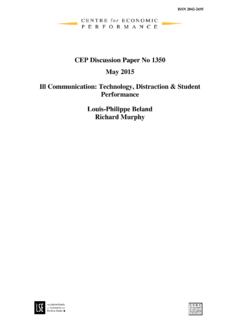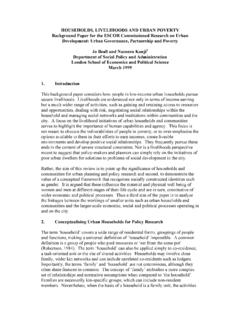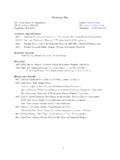Transcription of Fake News: Public Policy Responses - LSE Research Online
1 MEDIA Policy BRIEF 20 fake news : Public Policy Responses Damian Tambini The London school of Economics and political Science Department of Media and Communications ACKNOWLEDGEMENTS The LSE Media Policy Project is funded by the Higher Education Innovation Fund 5, with additional support from the Open Society Foundation. LSE Media Policy Project Series Editors: Damian Tambini, Emma Goodman The author would like to thank Emma Goodman, Nora Kroeger and Franco Polizzi for their valuable input. Creative Commons Licence, Attribution Non-Commercial. This licence lets others remix, tweak and build upon this work non-commercially. New works using this work must acknowledge the licensor and be non-commercial (you must give appropriate credit, provide a link to the license, and indicate if changes were made).
2 You don t have to license your derivative works on the same terms. March 2017 LSE Media Policy Project Suggested citation: Tambini, D. (2017). fake news : Public Policy Responses . Media Policy Brief 20. London: Media Policy Project, London school of Economics and political Science. Contents Key messages .. 1 Introduction .. 2 Six types of fake news : Unpacking the concept .. 3 news , truth and facts .. 6 fake news . Why now? Who benefits? .. 9 Advertising and fake news .. 10 Policy Responses to fake news .. 13 Closing remarks .. 16 1 Key messages The term fake news is ill-defined. Policymakers should be aware that the term has been used to serve the purposes of various political actors.
3 Some fake news problems do require action on the part of policymakers as well as media and tech companies, but the approach must be cautious, proportionate and protect free speech. In a small number of cases, deliberately misleading news that attempts to undermine elections could pose a threat to national security. Intermediaries such as Google and Facebook may be required to take such content down, but in most cases fact checking and monitoring will be sufficient. Recent studies suggest that a majority of citizens (both students and adults) lack the capacity to correctly differentiate fake news from verified content. Digital advertising revenue fuels fake news , and market mechanisms can be encouraged to respond to this problem.
4 Legitimate news sources, including critical voices, should be protected from interference by state bodies and also from threat, intimidation and exclusion from news gathering opportunities such as news conferences. The appropriate Policy response should be to encourage critical media literacy, self-regulation by platforms, and targeted enforcement in the very few cases that are threats to national security. New fines and changes in liability are not required, and legitimate media should be protected from accusations of fake news . 2 Introduction Let truth and falsehood grapple. Who ever knew Truth put to the worse in a free and open encounter? Milton An apparent proliferation of inaccurate and misleading news stories has led to calls for new Policy interventions, from fact checking by social media companies to new laws imposing fines for posting or sharing fake news .
5 This raises some difficult issues in media Policy . Is this a new problem? Is so called fake news distinct from longstanding problems with accuracy or objectivity in journalism? Is the controversy rather a response to the scale of current political changes, and their impact on various interested parties? Are there fundamental changes going on in our Western media systems which undermine traditional journalistic crafts of fact checking and verification, and incentivise more emotionally resonant content, at the expense of quality, reliable journalism? The call for new Policy Responses to the issue of fake news engages obvious problems of freedom of expression: decisions about the truth or falsity of a statement have tended to be left to journalists and the media themselves, and oversight of such decisions could compromise their independence and speech rights.
6 This paper sets out some of the groundwork for understanding and responding to the problem of fake news . 3 Six types of fake news : Unpacking the concept The term fake news , on closer inspection, turns out to refer to a range of phenomena: from deliberately misleading attempts to undermine elections or national security at one end of the continuum to any view that challenges consensus group think on the other. Each of these categories needs to be broken down further. They contain a variety of phenomena and require different Responses : 1. Alleged foreign interference in domestic elections through fake news It is claimed that Russian organisations have supported distribution of fake stories that support new populists such as Donald Trump and the Front National in France.
7 The European Union has funded a disinformation review: . The aim of this review is to monitor and fact-check what appear to be deliberate attempts to spread misinformation. There seem to be relatively few examples of deliberately fake stories propagated with the aim of affecting election results that are published in the language of the target country. 2. Ad-driven invention fake news boiler houses in Macedonia target resonance and share-ability ahead of any consideration for truth. Numerous investigations confirm that new ad models open new opportunities for people to make money through the peddling of fake news , and this may have been a factor in misinformation during the US presidential elections.
8 Social media companies are in a difficult position: they do not wish to actively engage as editors in the 4 process of news selection and distribution, but neither do they want to be seen as choosing to do nothing about this problem. It is of course theoretically possible for news sites or stories to fit into both categories 1 and 2. 3. Parody and satire One of the refreshing peculiarities of social media news is a new flourishing of political satire, and in particular, parody of news genres. Since Jonathan Swift s A Modest Proposal, it has been abundantly clear that this form of fake news is a particularly important form of political speech, and it is important to note that regulatory solutions should protect, and perhaps even encourage it.
9 A by-product of this genre has always been that a number of people will believe these parodies to be true. However as in the case of A Modest Proposal, when they are believed to be true, satire and parody are at their most powerful and are most worthy of protection. 4. Bad journalism In the history of journalism there are numerous infamous cases of journalists simply making it up. In celebrity gossip in particular, journalists have an interest in conspiring with the publicity-hungry subjects of stories to feed Public hunger for stories with scant regard for truth. Journalism sourcing ethics do not deal effectively with this. Since the UK Editors Code has been in existence, the most complained about article is consistently Article 1: Accuracy.
10 I) The Press must take care not to publish inaccurate, misleading or distorted information or images, including headlines not supported by the text. Since neither industry body IPSO, nor its predecessor the PCC pro-actively policed this article of the code (they responded to complaints) and since neither body sought to adjudicate accuracy itself (they focused on journalistic processes of taking care ), standards of accuracy in the press have not had a strong incentive to improve: readers were left to decide what was true and what was not and the assumption was that this would lead to at least some commercial pressure to verify.





